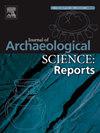第四纪晚期人类对基尔瓦海岸(坦桑尼亚)的占领:来自同位素地球化学的 OSL 年龄和古环境代用指标
IF 1.5
2区 历史学
0 ARCHAEOLOGY
引用次数: 0
摘要
我们报告了位于坦桑尼亚沿海基尔瓦地区的史前遗址 Mnaraeka 01 的新地质年代和古环境数据。该遗址最古老的人类活动痕迹来自于距今 7.1 ± 6 千年(ka)的地层,在该地层中发现了剥落的石块,但无法从技术类型上进行诊断。年代为 43.9 ± 2.4 ka 和 41.8 ± 2.1 ka 的地层单元出土的石器大致具有中石器时代(MSA)的特征,而年代为 10.0 ± 0.6 ka 的地层单元出土的石器可追溯到晚石器时代(LSA)。对遗址中的 8 个土壤样本进行了稳定碳和氮同位素分析,结果表明,δ13C 值范围在 -19.3‰ 至 -27.8‰ 之间(与 VPDB 相比),反映了定居时期的草地-林地生境。研究结果表明,在寒冷的海洋同位素阶段(MIS)4 开始期间,在海因里希事件 4 和 5 的寒流之间,以及在全新世最适宜气候期间,东非沿海林地植被和人类觅食种群持续存在。我们的研究表明,坦桑尼亚沿海的石器时代考古学有可能揭示沿海生态区在第四纪晚期多变的气候条件下作为人类潜在避难所的作用。此外,来自 Mnaraeka 01 的新数据集为了解基尔瓦盆地保存的深厚人类历史打开了一扇窗。本文章由计算机程序翻译,如有差异,请以英文原文为准。
Late Quaternary human occupation of the Kilwa coast (Tanzania): OSL ages and paleoenvironmental proxies from isotope geochemistry
We report new geochronologic and paleoenvironmental data for Mnaraeka 01, a prehistoric site located in the Kilwa district of coastal Tanzania. The oldest trace of human activity at the site comes from a context dated to 71 ± 6 thousand years ago (ka) where flaked stones but techno-typologically non-diagnostic were uncovered. Stratigraphic units dated to 43.9 ± 2.4 ka and 41.8 ± 2.1 ka have revealed stone artifacts broadly characteristic of the Middle Stone Age (MSA) while a context dated to 10.0 ± 0.6 ka has produced artifacts referrable to the Later Stone Age (LSA). Eight soil samples from the site subject to stable carbon and nitrogen isotope analyses reflect grassy-woodland habitat during the settlement episodes with δ13C values ranging from −19.3‰ to −27.8‰ (vs. VPDB). The results demonstrate the persistence of coastal woodland vegetation and human foraging populations in coastal East Africa during the onset of the cold Marine Isotope Stage (MIS) 4, between the cold spells of Heinrich Events 4 and 5, and during the Holocene Climatic Optimum. Our study shows that the Stone Age archaeology of coastal Tanzania has the potential to shed light on the role of coastal ecozones as potential refugia for human populations during variable climate conditions of the late Quaternary. Furthermore, the emergent datasets from Mnaraeka 01 open a window into the deep human history preserved in the Kilwa basin.
求助全文
通过发布文献求助,成功后即可免费获取论文全文。
去求助
来源期刊

Journal of Archaeological Science-Reports
ARCHAEOLOGY-
CiteScore
3.10
自引率
12.50%
发文量
405
期刊介绍:
Journal of Archaeological Science: Reports is aimed at archaeologists and scientists engaged with the application of scientific techniques and methodologies to all areas of archaeology. The journal focuses on the results of the application of scientific methods to archaeological problems and debates. It will provide a forum for reviews and scientific debate of issues in scientific archaeology and their impact in the wider subject. Journal of Archaeological Science: Reports will publish papers of excellent archaeological science, with regional or wider interest. This will include case studies, reviews and short papers where an established scientific technique sheds light on archaeological questions and debates.
 求助内容:
求助内容: 应助结果提醒方式:
应助结果提醒方式:


